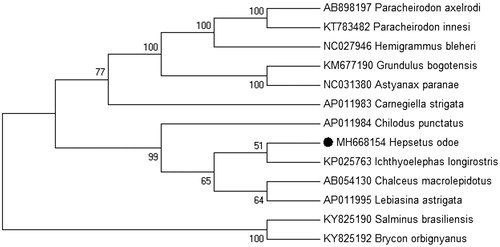Abstract
Here, we report the complete mitochondrial genome sequence of Hepsetus odoe. The genome is found to be 16,802 bp in length and has a base composition of A (28.67%), G (15.86%), C (31.10%), and T (24.37%). Similar to other Hepsetus species, it contains a typically conserved structure including 13 protein-coding genes, two rRNA genes, one control region (D-loop), and 22 tRNA genes. The proportion of coding sequences with a total length of 11,435 bp is 68.06%, which encodes 3816 amino acids. All protein-coding genes started with Met, ND1, CO2, ATP8, ATP6, CO3, ND4L, ND5, ND6 and CytB ended by TAA as a stop codon, ND2, ND3 ended by TAG as a stop codon, CO1, ND4 ended by a single AGG. The lengths of 12S ribosomal RNA and 16S ribosomal RNA are 955 bp and 1684 bp, respectively. The length of control region is 1142 bp, ranging from 15,660 bp to 16,802 bp. The complete mitochondrial genome sequence provided here would be helpful in understanding the evolution of ratite and conservation genetics of Hepsetus odoe in future.
Hepsetus odoe, belongs to the family Hepsetus, Hepsetidae, is a fish which distributes in the freshwater basins in central and western Africa, from Senegal to Angola (Decru et al. Citation2013). Although the part of fragment mitochondrial (mt) genomes belonging to Hepsetus odoe have been included in GenBank, the complete Hepsetus odoe mt genome sequence still has not been reported yet.
The specimen was collected from a tributary of Niagara Falls (3°42′08″N, 27°52′12″E) and stored in a refrigerator of −80 °C in Zhejiang Engineering Research Center for Mariculture and Fishery Enhancement Museum. We got the total genomic DNA from muscle tissue of three different individuals using the phenol–chloroform method (Barnett and Larson Citation2012). The calculation of base composition and phylogenetic construction were conducted by MEGA6.0 software (Tamura et al. Citation2013). The transfer RNA (tRNA) genes were generated with the program tRNAs-can-SE (Lowe and Eddy Citation1997). The mt genome sequence of Hepsetus odoe with the annotated genes was deposited in GenBank with the accession number of MH668154.
Similar to the typical mitogenome of vertebrates, the mitogenome of Hepsetus odoe is a closed double-stranded circular molecule of 16802 nucleotides (GenBank accession No. MH668154), which contains 13 protein-coding genes, two ribosomal RNA genes, 22 tRNA genes and two main non-coding regions (Boore Citation1999; Zhu et al. Citation2018; Zhu et al. Citation2018). The contents of A, G, T, and C are 28.67%, 15.86%, 24.37%, and 31.10%, respectively. Most mitochondrial genes are encoded on H-strand except for ND6 and eight tRNA genes (Gln, Ala, Asn, Cys, Tyr, Ser, Glu, and Pro), which are encoded on the L-strand. The proportion of coding sequences with a total length of 11,435 bp is 68.06%, 13 protein-coding (PCGs) genes encode 3816 amino acids in total. AT and GC contents of mt genome are 53.04% and 46.96%, respectively. All the protein-coding genes use the initiation codon ATG except COI uses GTG, which is quite common in vertebrate mtDNA (Miya et al. Citation2001; Liu et al. Citation2016). ND1, CO2, ATP8, ATP6, CO3, ND4L, ND5, ND6 and CytB ended by TAA as a stop codon, ND2, ND3 ended by TAG as a stop codon, CO1, ND4 ended by a single AGG. The 12S rRNA and 16S rRNA are 955 and 1684 bp, which are both located in the typical positions between tRNA-Phe and tRNA-Leu (UUA), separated by tRNA-Val. The origin of light-strand replication is located in a cluster of five tRNA genes (WANCY) as in other vertebrates (Petrillo et al. Citation2006), The length of control region is 1142 bp, ranging from 15,660 bp to 16802 bp.
Phylogenetic analysis included mt genome of Hepsetus odoe and the other 13 species that are from the order Hemigrammus, Paracheirodon, Carnegiella, Chilodus, Ichthyoelephaa, Lebiasina and others, which belong to Characoidei. The results of the present study support that Hepsetus odoe has a closest relationship with Ichthyoelephaa ().
Figure 1. Phylogenetic tree derived from NJ based on concatenated nucleotide sequences of twelve PCGs. Including Paracheirodon axelrodi, Paracheirodon innesi, Grundulus bogotensis, Astyanax paranae, Carnegiella strigata,Chilodus punctatus, Hepsetus odoe, lchthyoelephas longirostris, Chalceus macrolepidotus, Labiasina astrigata, Salminus brasiliensis, Brycon orbignyanus.

Disclosure statement
The authors report no conflicts of interest. The authors alone are responsible for the content and writing of the paper.
References
- Barnett R, Larson G. 2012. A phenol-chloroform protocol for extracting DNA from ancient samples. Methods Mol Biol. 840:13–19.
- Boore JL. 1999. Animal mitochondrial genomes. Nucleic Acids Res. 27:1767–1780.
- Decru E, Snoeks J, Vreven E. 2013. The true identity of the holotype of Hepsetus odoe and the names of the two West African species of Hepsetus (Teleostei: Hepsetidae). Ichthyol Explor Fres. 24:187–192.
- Liu J, Ding Q, Gao L. 2016. The complete mitochondrial genome of North Island brown kiwi (Apteryx mantelli. Mitochondrial DNA Part B-Resources..
- Lowe T, Eddy S. 1997. tRNAscan-SE: a program for improved detection of transfer RNA genes in genomic sequence. Nucleic Acids Res. 25:955–964.
- Miya M, Kawaguchi A, Nishida M. 2001. A case study for moderate-scale evolutionary genomics with 38 newly determined complete mitochondrial DNA sequences. Mol Biol Evol. 18:1993–2009.
- Petrillo M, Silvestro G, Nocera PPD, Boccia A, Paolella G. 2006. Stem-loop structures in prokaryotic genomes. BMC Genomics. 7:170.
- Tamura K, Stecher G, Peterson D, Filipski A, Kumar S. 2013. MEGA6: Molecular Evolutionary Genetics Analysis version 6.0. Mol Biol Evol. 30:2725–2729.
- Zhu K, Gong L, Jiang L, Liu L, Lü Z, Liu BJ. 2018. Phylogenetic analysis of the complete mitochondrial genome of Anguilla japonica (Anguilliformes, Anguillidae). Mitochondrial DNA B. 3:536–537.
- Zhu K, Lü Z, Liu L, Gong L, Liu B. 2018. The complete mitochondrial genome of Trachidermus fasciatus (Scorpaeniformes: Cottidae) and phylogenetic studies of Cottidae. Mitochondrial DNA B. 3:301–302.
